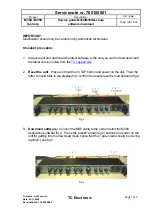
Chapter 5 Advanced IP configuration
147
Using the BayStack Instant Internet Management Software Version 7.11
•
Port – If you are specifying a range of ports, this is the beginning port
number. This is meaningful only for TCP or UDP filter rules and specifies
the port of the data packet.
•
Ending Port – If you are specifying a range of ports, this is the ending
port number in the range. This is meaningful only for TCP or UDP filter
rules. The ending port must be greater than the beginning port.
9
In the Destination area, enter the following information:
•
Address – The IP address of the destination. You can use any valid IP
address or host name. The default is any destination address.
•
Bits – The number of bits of the network portion of the destination
address. The default is 32.
•
Port – If you are specifying a range of ports, this is the beginning port
number. This is meaningful only for TCP or UDP filter rules, and
specifies the port of the data packet.
•
Ending Port – If you are specifying a range of ports, this is the ending
port number in the range. This is meaningful only for TCP or UDP filter
rules. The ending port must be greater than the beginning port.
10
Click OK.
You return to the Filter Configuration dialog box, and the filter you just
configured appears in the list.
If you define more than one filter, you can change the order in which the
filters are executed by selecting a filter and using the arrows to the left to
move the filter up or down in the list.
11
Click OK.
The <interface> Filter Configuration dialog box opens
(Figure 70)
.
12
Apply the filter to the interface (see below).
Note:
Instant Internet removes the IP options field from received
packets, including the source routing option. This prevents Instant
Internet from forwarding source-routed packets under any circumstances,
and it generally processes such packets as if addressed to the unit itself.
Summary of Contents for 400
Page 16: ...16 Contents 300868 G ...
Page 22: ...22 Figures 300868 G ...
Page 24: ...24 Tables 300868 G ...
Page 92: ...92 Chapter 2 User access administration 300868 G ...
Page 114: ...114 Chapter 3 Internet activity logging 300868 G ...
Page 166: ...166 Chapter 5 Advanced IP configuration 300868 G ...
Page 200: ...200 Chapter 6 IP security and VPN 300868 G ...
Page 256: ...256 Chapter 8 Advanced communications configuration 300868 G ...
Page 302: ...302 Chapter 10 Instant Internet unit configuration support and diagnostics 300868 G ...
Page 314: ...314 Appendix A Troubleshooting and error messages 300868 G ...
Page 344: ......
















































